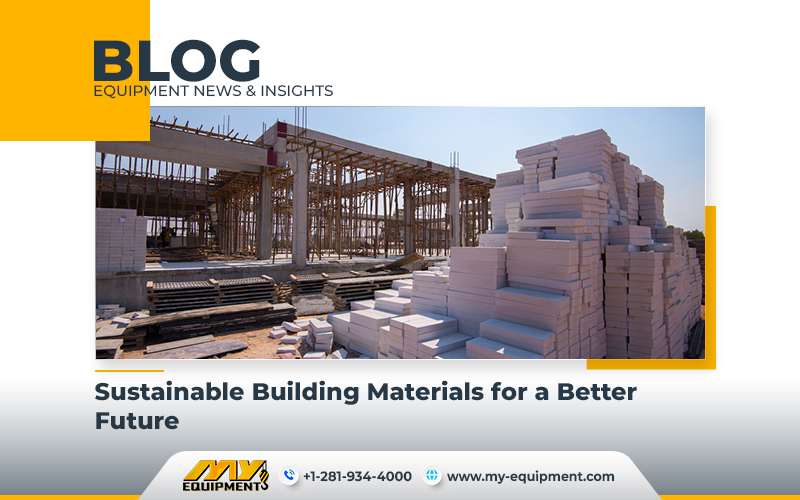Sustainability is one of the topics that frequently comes up nowadays while talking about the future of construction. According to Architecture2030, the building industry is one of the biggest producers of greenhouse gas emissions (GHG), with the occupied buildings accounting for close to 40 percent of the worldwide GHG emissions.
The production and sourcing of building materials also has a significant impact on climate change.
A United Nations Environment Programme report claims that a large amount of energy and greenhouse gas emissions are added to the life cycle impact of buildings by the manufacture of building products and components, which accounts for about 40–50% of the overall flow of raw materials in the global economy. Concerns about the shortage of mineral resources, particularly water, contribute to the necessity of expanding the restricted focus on the building energy use and the accompanying greenhouse gas emissions.
It is obvious that more needs to be done by the construction sector to safeguard the environment. Encouraging sustainability will benefit both present and future generations.
What is the good news?
Experts of heavy equipment and construction industry are already moving in the right way. In order to replace products like concrete, a significant source of emissions, builders are increasingly investigating some sustainable construction alternatives.
Mentioned below are some environmentally friendly building materials. Check them out to see if you can incorporate them into your work.
Flexible Concrete
Concrete that can endure bending is referred to as flexible concrete or Engineered Cementitious Composite (ECC). Bendable concrete is more effective at absorbing shock and is way more resistant to cracking than traditional concrete, which is brittle and readily breaks or cracks.
This is because ECC has tiny fibers made of polymers that make the material more ductile. Although the components of bendable concrete are the same as those of standard concrete, it is these fibers that give ECC its greater flexibility and durability.
Bendable concrete is also more environmentally friendly. Infusing it with carbon dioxide makes the concrete stronger while using less cement and producing fewer greenhouse gas emissions.
Cost Effective
ECC’s ductility also lowers building costs on a financial and environmental level because, unlike traditional concrete, which breaks easily and frequently needs repairs, bendable concrete can withstand greater pressures, requiring less upkeep and repair, which saves time, materials, and carbon emissions.
Concrete that is capable of being bent has been used for many years and has shown itself to be reliable. On a Michigan bridge deck, for instance, the ECC link slab that was utilized to replace a traditional expansion joint has lasted more than 10 years without needing any maintenance or repairs.
Mass timber
Mass timber products are engineered by mechanically joining softwood species to create large prefabricated wooden components. They are used more and more nowadays for roofing, flooring, beams, and columns.
Mass timber offers a sustainable alternative to materials with high carbon footprints like steel and concrete. It really reduces emissions and construction waste, while the buildings can be built more efficiently.
Recycling Materials
The practice of reusing and recycling materials is a cornerstone of construction sustainability. Simply by incorporating some recycled materials, construction professionals can drastically reduce waste and environmental impact.
Utilizing recycled materials often leads to cost savings while simultaneously helping to improve a building’s aesthetics and functionality. Plus, it also helps to divert materials from landfills, contributing to waste reduction.
Bamboo
Bamboo is an incredibly versatile and sustainable building material that is readily available worldwide and generates minimal waste.
Bamboo is very commonly used in both structural and ornamental aspects of construction, as exemplified by projects like the Tiing Hotel in Bali. Its natural resilience complements the tropical climates seamlessly.
Mycelium
Mycelium, the vegetative part of fungi, challenges some of the traditional construction materials. When dried, it exhibits impressive strength, fire resistance, waterproofing, and biodegradability. Mycelium can be shaped into bricks when combined with materials like wood and sawdust. This process results in minimal waste and negligible adverse effects on the environment.
Precast Concrete
Precast concrete is manufactured offsite, demanding less energy and fewer resources. It is employed in iconic structures, such as the Sydney Opera House. The production of precast concrete slabs employs reusable molds and forms, minimizing waste generation and environmental impact.
3D-Printed Concrete
3D printing concrete has revolutionized construction by enabling efficient and sustainable building processes. It allows for the rapid realization of some precise digital designs, thereby reducing energy consumption and waste. Some great projects like the world’s longest 3D-printed bridge highlight the immense potential of this technique in creating sustainable structures.


 1400 Broadfield Blvd, Houston, TX 77084,
USA.
1400 Broadfield Blvd, Houston, TX 77084,
USA.